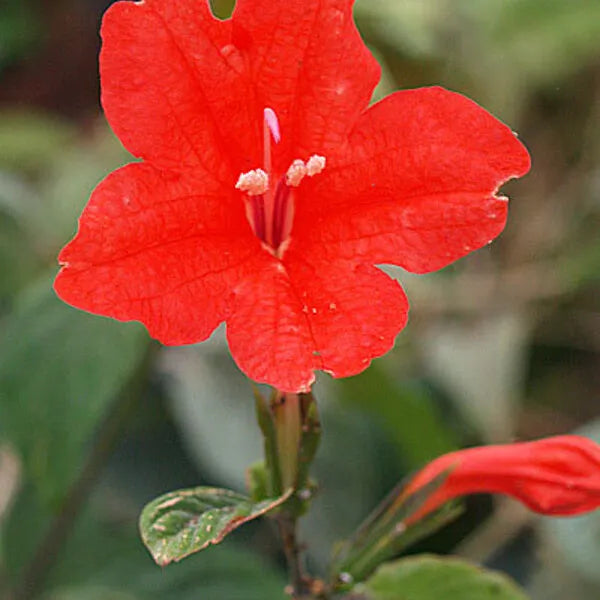
Red Ruellia,Ruellia Affinis,Ruellia Elegans
Selling Size : Single Plant | Pot Included | Secure Packing
"Red Ruellia," Ruellia affinis, and Ruellia elegans. It's important to note that Ruellia elegans is often referred to as "Red Ruellia" or "Brazilian Petunia," and Ruellia affinis is also known as "Red Ruellia" or "Wild Petunia." While they share similar characteristics and care, there might be slight nuances.
Here's a general care guide that applies to these beautiful, often red-flowering Ruellia varieties:
1. Light:
Full sun to partial shade is ideal. These Ruellia varieties thrive in locations where they receive plenty of sunlight. Full sun generally leads to the most abundant flowering.
In very hot climates (like parts of India, especially during peak summer), some afternoon shade can be beneficial to protect them from the harshest sun and prevent leaf scorch.
Insufficient light can result in leggy growth and fewer blooms.
2. Watering:
Consistent moisture is preferred, but they are quite adaptable. While they can tolerate some drought once established, especially in the ground, they will perform best with regular watering, allowing the top inch or two of soil to dry out slightly between waterings.
They can even tolerate somewhat wet conditions, but well-draining soil is still recommended to prevent root rot in the long term.
Reduce watering in cooler months when growth slows down.
3. Soil:
Well-draining soil is crucial. A rich, fertile, well-drained soil is ideal.
They are not overly particular about soil pH and can grow in acidic, neutral, or alkaline soils.
For container planting, use a good quality potting mix with added perlite or grit for drainage.
4. Temperature and Humidity:
Warm temperatures are favored. These are tropical to subtropical plants and thrive in warm, humid environments.
Ideal temperatures are generally between 20-38°C (68-100°F).
They are not frost-hardy. If you live in a region with cold winters, they are often grown as annuals or brought indoors for overwintering. In warmer climates (like many parts of India), they can be grown as perennials.
5. Fertilizer:
Light feeding is generally sufficient. These plants are not heavy feeders.
You can apply a balanced, slow-release fertilizer in spring at the beginning of the growing season to encourage healthy foliage and abundant blooms.
Avoid over-fertilizing, as this can lead to excessive foliage growth at the expense of flowers.
6. Pruning:
Pruning helps maintain shape and encourages more blooms.
Deadhead spent flowers regularly to promote continuous blooming and prevent excessive self-seeding (as some Ruellia species can be quite vigorous in spreading).
You can cut back leggy stems to encourage bushier growth.
In colder climates, if overwintering indoors, you may want to prune them back heavily before bringing them in. In evergreen climates, light pruning as needed is fine.
7. Propagation:
Very easy to propagate!
Cuttings: Take 4-6 inch stem cuttings, remove leaves from the bottom half, and plant in moist, well-draining soil. Rooting hormone is optional but can speed up the process. Keep the soil moist until roots establish.
Seeds: They readily self-seed. You can collect seeds from the mature pods and sow them.
Division: Larger clumps can be divided, especially in spring.
8. Pests and Diseases:
Generally, Ruellia plants are low-maintenance and relatively pest and disease-free.
The most common issue is root rot, almost always due to consistently waterlogged soil. Ensure good drainage.
Occasionally, you might see common garden pests like spider mites (look for fine webbing and tiny white splotches on leaves) or mealybugs. Treat with horticultural oil or insecticidal soap if necessary.
Important Note on Invasiveness: Some Ruellia species, particularly Ruellia simplex (Mexican Petunia, which often has purple flowers), are known to be quite aggressive self-seeders and can become invasive in certain climates. While Ruellia elegans and Ruellia affinis are less commonly cited as invasive as R. simplex, they can still spread readily. If you are concerned about spread, be diligent about deadheading flowers to prevent seed formation, or consider planting them in containers.
By providing these conditions, your Red Ruellia, Ruellia affinis, or Ruellia elegans will reward you with a profusion of beautiful, trumpet-shaped red flowers throughout the warmer months!

